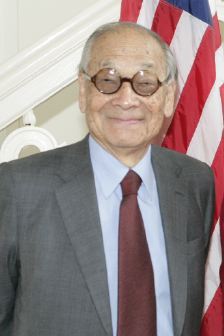
Ieoh Ming Pei was a Chinese-American architect. Raised in Shanghai, Pei drew inspiration at an early age from the garden villas at Suzhou, the traditional retreat of the scholar-gentry to which his family belonged. In 1935, he moved to the United States and enrolled in the University of Pennsylvania's architecture school, but he quickly transferred to the Massachusetts Institute of Technology. He was unhappy with the focus at both schools on Beaux-Arts architecture, and spent his free time researching emerging architects, especially Le Corbusier. After graduating, he joined the Harvard Graduate School of Design (GSD) and became a friend of the Bauhaus architects Walter Gropius and Marcel Breuer. In 1948, Pei was recruited by New York City real estate magnate William Zeckendorf, for whom he worked for seven years before establishing an independent design firm in 1955, I. M. Pei & Associates. In 1966 that became I. M. Pei & Partners, and in 1989 became Pei Cobb Freed & Partners. Pei retired from full-time practice in 1990. In his retirement, he worked as an architectural consultant primarily from his sons' architectural firm Pei Partnership Architects.

The Puck Building is a historic building located in the Nolita neighborhood of Manhattan, New York City. It occupies the block bounded by Lafayette, Houston, Mulberry and Jersey Streets.

Robert Mills was a South Carolina architect known for designing both the first Washington Monument, located in Baltimore, Maryland, as well as the better known monument to the first president in the nation's capital, Washington, DC. He is sometimes said to be the first native-born American to be professionally trained as an architect. Charles Bulfinch of Boston perhaps has a clearer claim to this honor.
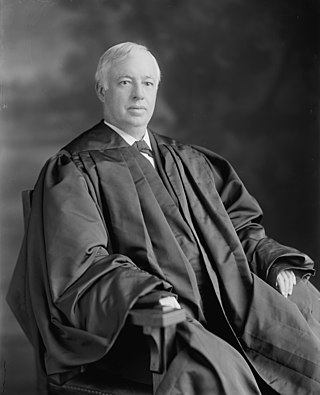
Joseph Rucker Lamar was an Associate Justice of the United States Supreme Court appointed by President William Howard Taft. A cousin of former associate justice Lucius Lamar, he served from 1911 until his death in 1916.

Glynn Academy (GA) is an American public high school in Brunswick, Georgia, United States, enrolling 1,900 students in grades 9–12. Along with Brunswick High School, it is one of two high schools in the Glynn County School System. Glynn Academy offers technical, academic, and Advanced Placement programs and is accredited by the Georgia Department of Education and the Southern Association of Colleges and Schools. The school has consistently been ranked among the top public high schools in the United States by Newsweek.

The John F. Seagle Building is a historic building located at 408 West University Avenue in Gainesville, Florida, in the United States. Built in 1926, it was designed by noted University of Florida architect and professor Rudolph Weaver and built by G. Lloyd Preacher & Company.
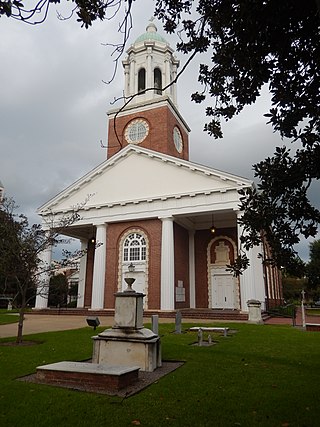
Saint Paul's Church is a historic Episcopal church in downtown Augusta, Georgia, adjacent to Riverwalk Augusta. A member of the Episcopal Diocese of Georgia, Saint Paul's conducts its worship services using the 1979 Book of Common Prayer. The church, located on the corner of 6th and Reynolds Streets, is the oldest church congregation in Augusta. It was established in 1750 by the Church of England at the site of Fort Augusta. There have been five churches on the site. The current church building, which combines features of Federal architecture with those of the Georgian and Greek Revival styles, was designed by Henry Ten Eyck Wendell and dedicated in 1920. It can seat up to 600 people.
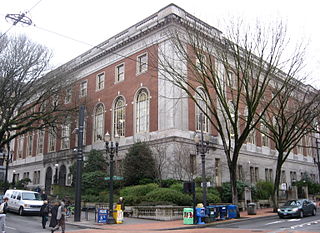
The Central Library is a three-story public library branch in downtown Portland, Oregon, United States. Opened in 1913, it serves as the main branch of the Multnomah County Library system. In 1979, the Georgian style building was added to the National Register of Historic Places as the Central Building, Public Library. The library underwent major structural and interior renovations in the mid 1990s.

The Crescent Brass and Pin Company Building is located at 5766 Trumbull Street in Detroit, Michigan. It was listed on the National Register of Historic Places in 2003. It is currently known as the Research Lofts on Trumbull.

Augusta Downtown Historic District is a historic district that encompasses most of Downtown Augusta, Georgia and its pre-Civil War area.

William Lee Stoddart (1868–1940) was an architect who designed urban hotels in the Eastern United States. Although he was born in Tenafly, New Jersey, most of his commissions were in the South. He maintained offices in Atlanta and New York City.

Hotel Paso del Norte is a historic 351-room luxury 4 1/2 star hotel. It is located in El Paso, Texas, less than one mile north of the international border with Mexico. The hotel originally opened on Thanksgiving Day 1912, and was designed by Trost & Trost. The building was added to the National Register of Historic Places on January 5, 1979. It recently underwent a complete and total renovation, and reopened its doors as part of Marriott's Autograph Collection on October 8, 2020.

Cast Iron House at the corner of Franklin Street and Broadway in the Tribeca neighborhood of Manhattan, New York City, formerly known as the James White Building, was built in 1881-82 and was designed by W. Wheeler Smith in the Italianate style. It features a cast-iron facade, and is a good example of late cast-iron architecture. The building was renovated by architect Joseph Pell Lombardi in 2000, and a restoration of the facade began in 2009. The building once housed the offices of Scientific American from 1884 to 1915, but it was primarily used in connection with the textile trade.

The Medical Arts Building is a Beaux-Arts style building located at the northern end of Downtown Atlanta. The 12-story brick and limestone building by architect G. Lloyd Preacher, also designer of Atlanta City Hall, was constructed in 1927. In addition to its medical facilities - deemed as some of the most modern and well-equipped when it opened, the building once featured a cafeteria, drugstore and telegraph office. It was also amongst the first to have a covered parking garage. However, its nearly 89,000 square feet (8,300 m2) of space have been vacant since 1995.

The Charles M. Bailey Public Library is the public library serving Winthrop, Maine. It is located at 39 Bowdoin Street, near the town center. It was officially established by the town on November 4, 1916, and opened to the public on December 2, 1916. The library became a free library in 1970, and was added to the National Register of Historic Places in 1985. The original granite structure was designed by prominent Maine architect John Calvin Stevens, and his son John Howard Stevens. The 2015 addition was designed by Maine architect Philip M Locashio.

Lewis F. Goodrich (1848-1929), frequently known as L. F. Goodrich, was an American architect based in Augusta, Georgia. He designed public buildings in Georgia and South Carolina.

Joseph Rucker Lamar Boyhood Home is the boyhood home of Joseph Rucker Lamar in Augusta, Georgia. Lamar served as Justice of the United States Supreme Court. The home was added to the National Register of Historic Places on June 13, 1996. It is located at 415 7th Street. The house was constructed in 1860. It is located in the Augusta Downtown Historic District, is the headquarters of Historic Augusta, and is used as a visitors center for the Boyhood Home of Woodrow Wilson.
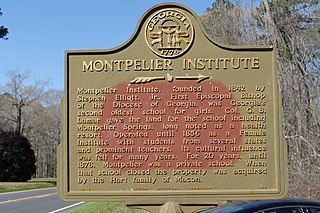
First known as the Montpelier Institute and later as the Montpelier Collegiate Institute, the Montpelier Female Institute was a school founded by Episcopal Bishop Stephen Elliott at Montpelier Springs, Monroe County, Georgia in 1841, and is notable as one of the earliest in the state to admit girls. After changing hands several times, it finally closed in 1878.
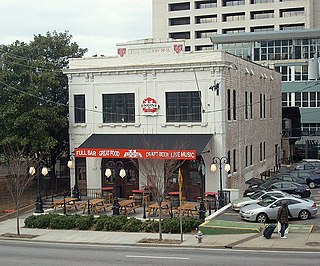
The Fire Station No. 11 in Atlanta, Georgia, at 30 North Ave., was built in 1907. It was listed on the National Register of Historic Places in 1980.

The Glenn Building is a historic building on Marietta Street in downtown Atlanta, Georgia, United States. Built in 1923 as an office building, the building was converted to a boutique hotel in 2006 and added to the National Register of Historic Places in 2008.























